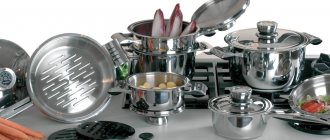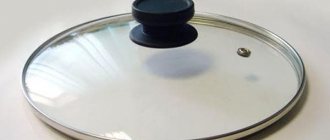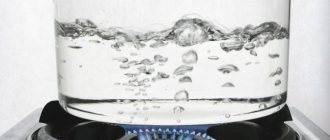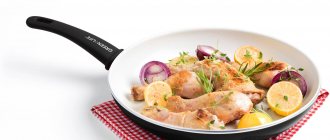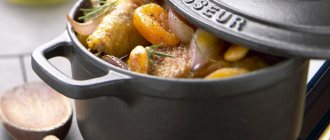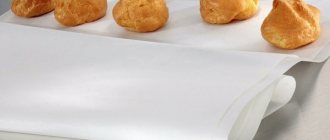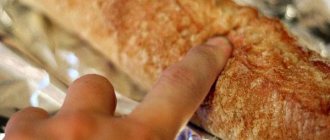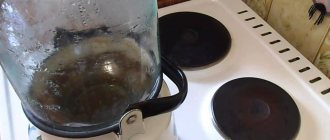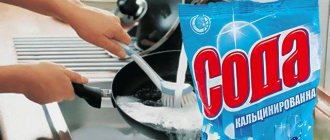Enameled cookware is widely used in our kitchens. This material is durable, reliable, and functional. In terms of safety, it is second only to glassware. In such saucepans you can cook even dishes for the smallest family members. Neat dishes look stylish in any interior. But at the same time, this coating is quite capricious; for example, it cannot be rubbed with a metal sponge. From the article you will find out whether an enamel pan can be placed in the oven and how to care for it.
Features of materials and coating
To understand which pan is better and more practical, let’s look at the features and production technologies, the pros and cons of each type.
How are enamel pans made and what are their advantages?
Classic pans with an enamel coating are made of carbon steel. As a rule, they have a thick body, hence the rather impressive weight. Carbon steel is a porous and capricious material, which is why it is coated with enamel on the outside and inside.
The enamel mixture is prepared from a mixture of glass and ceramic particles. The technology is not new; in Russia there are factories producing enamel cookware that are more than 100 years old.
Before applying protective and decorative enamel, the dishes are treated with acids and primed. After drying, the products are dipped in enamel and sent to ovens for baking at a temperature of 800-850 °C. Using new technologies, enamel is sprayed. Enamel the pots at least twice, making sure to bake them after each application.
The final layer of enamel is applied under visual control so that there are no gaps, sagging or unevenly covered areas on the body. After the final firing, the pots are ready for decoration and labeling.
The result is dishes with a smooth and durable glassy coating that is resistant to high temperatures, saline solutions, and acids. The properties of enamel are similar to glass, but not as inert.
Advantages:
- does not absorb odors and tastes, there are no pores;
- does not oxidize or rust;
- food does not react with metals, the taste and composition of the product does not change;
- Cooked food can be left in the pan for storage.
The disadvantages of enamel pans include:
- darkening of enamel, staining from products;
- prone to scratches, do not use abrasives for cleaning;
- chips of the enamel coating due to falls and careless handling;
- burning and sticking of some products.
Enameled carbon steel pans are generally compatible with induction cooktops.
What is attractive about stainless steel cookware?
Stainless steel is an alloy of iron with additives that prevent oxidation and rust formation. The consumer properties of the product depend on the type of alloy. Chromium-nickel steel grade 304 is considered the best today.
High-quality stainless steel pans last for many years, they do not scratch, do not burn, or crack. Lack of coverage is always a big plus. Stainless steel is inert and safe.
There are many types of stainless steel pans, as we have already discussed. Here are the materials, the method of surface treatment (matte, glossy), and additional layers in the bottom, and models for different tasks.
When choosing, it is important to pay attention to the following characteristics:
- The type and thickness of the bottom - thin is suitable for soup, dumplings, pasta, eggs, vegetables, but you cannot stew or fry in such a container. Thin stainless steel will burn out faster, although the price of such options is much lower. The multi-layer bottom turns the pan into a cauldron and frying pan; the possibilities and range of prepared dishes expands.
- Case thickness. Thin walls are for cooking, thick walls are for stewing and long-term heat treatment. In thick dishes, food takes longer to cool.
Advantages:
- heats up quickly - water of the same volume will boil faster in a stainless steel pan than in an enameled one;
- it is not damaged by high and low temperatures, it is resistant to changes, that is, you can pour boiling water and immediately pour in cold water;
- is not afraid of scratches, even with minor damage to the surface it remains suitable for use;
- does not heat up to high temperatures.
Popular brands
It is believed that the highest quality enamel cookware comes from Japan. However, this is a misconception - as in the case of Russian manufacturers, Japanese products can also be of low quality, so you should pay attention first of all not to the country of manufacture, but to the brand. Among the well-proven industries, the following can be distinguished.
Ejiry
One of the largest Japanese companies producing enamel-coated cookware. Externally, it is clearly recognizable by the abundance of patterns and floral ornaments on a light background. Such dishes are of high quality, which is due to the use of glass enamels with the addition of powdered sugar.
Japonica
This series of dishes is designed in the Provence style, therefore it is distinguished by the use of delicate colors and an abundance of romantic floral designs. The enamel for making such pans is made from the highest quality and natural materials.
Thermosol
Finnish-made cookware is in great demand, especially the Termosol brand, which is one of the world leaders in the market for the production of kitchen utensils. The basis for the manufacture of enameled cookware is carbon steel, and it is covered with a dense layer of enamel , which can withstand fairly high temperatures without any deformation or damage to the integrity of the coating.
Metrot
In Europe, tableware from Metrot (Serbia) has long been in consistently high demand, the main advantages of which include exceptional quality, environmental safety, and stylish colorful design. The enamel coating is made of natural materials, applied in an even layer, and does not require special care. This brand produces not only saucepans, but also teapots, Turks and the most common ladles and scoops.
Products from Germany have earned the best user reviews
By the way, domestic manufacturers also make dishes that are practically not inferior in quality to their imported counterparts. Among the most popular are “Novomoskovskaya dishes” and “Lysvensky enamels”. A distinctive feature of the products is their high quality, which has been maintained for almost a hundred years.
Among other domestic enterprises, the following two can be noted.
- “Emal” is a company from Magnitogorsk that specializes in the production of high-quality and very interesting, from a decorative point of view, tableware. Thanks to the use of high-tech equipment, the manufacturer is able to maintain the cost of tableware at an affordable level.
- Steelemal is a subsidiary of the large metallurgical magnate Severstal. The dishes of this brand are presented in the widest range and are of truly European quality.
Stainless steel
A popular and affordable type of ovenware is made from stainless steel. And this is explained by several facts: this type of metal is not afraid of corrosion; such dishes are suitable for long-term use; keeps food fresh thanks to its bactericidal properties; this alloy is relatively inexpensive in cost. Stainless steel cookware is a real boon for the housewife. After all, sets of pots, bowls, and cups are absolutely diverse in terms of sizes and shapes. For example, the Peterhof PH-15490 pan for baking cupcakes and muffins is very popular. Also, stainless steel pans can be easily placed in the oven for preparing any delicacies. It cooks food quickly and does not burn.
Cast iron
Cast iron cookware will last for many, many years and does not require special care. You can wash it with any means, including abrasive ones (it is not afraid of powder or soda, and even metal scrapers). You can store cast iron pans one inside the other - they will not be scratched. Cast iron heats up quickly, but cools slowly and releases heat gradually, so the dish is heated evenly and will retain its temperature longer after turning off the oven. Food cooks faster in cast iron, retains all its taste properties and does not burn; moreover, cast iron becomes saturated with oil over time and improves its non-stick properties.
The only negative is that these dishes are very heavy.
How to clean and wash enamel cookware after using it in the oven
It is unlikely that you will be able to bake anything in a gas oven without carbon deposits. When inexperienced housewives start cooking in the oven, the food often burns. Regular detergents cannot remove stains.
There are several surefire ways to get rid of carbon deposits on enamel:
Soda and vinegar. During the neutralization reaction, oxygen is released. It destroys pollution. Vinegar is used to whiten darkened enamel. The surface is rubbed or a towel placed inside is moistened with 6% table vinegar. Leave for 12 hours. After this, the enamel is easy to wash. Soda is used in the form of a paste. Experienced housewives recommend adding hydrogen peroxide to it instead of water;
Vinegar is used to whiten darkened enamel.
Mustard. Exhausted or expired spice from tubes or jars is applied to the stain or the entire surface. Mustard powder is used for washing. It is diluted in the form of a paste or poured onto wet soot. After 4 hours it will be easier to clean it.
Mustard powder is diluted in the form of a paste or poured onto wet soot.
The dishwasher and Finish tablets work well with contaminated enamel. Sometimes it is enough to soak the utensils in water and leave them overnight.
A few rules on how to wash enamel products:
- Do not scrape the coating with a knife, use abrasive products or hard metal scourers for washing;
- It is not recommended to use metal spoons for stirring; they leave dark streaks on the coating and damage the protective layer;
- New dishes must be boiled with a salt solution - 2 tbsp. spoons per 1 liter of water;
It is not recommended to use metal spoons for stirring; they leave dark streaks on the coating.
It is prohibited to pour cold water into heated dishes. Temperature differences cause the coating to crack and large, deep chips form. It must be filled with hot water or pre-cooled at room temperature.
Restoring enamel
The easiest way to make minor repairs to a damaged surface is to use enamel paint, which is available in spray cans:
- "Nitroenamel";
- “White enamel”;
- "Bath enamel".
Before restoring the enamel on the pan, it is necessary to clean the damaged area, degrease it and dry it. After this, you can spray paint onto the chip, following the instructions on the label. Enamel can only be applied to areas that do not come into contact with food.
https://www.youtube.com/watch?v=ytcreatorsru
You can repair the pan using a soldering iron. To do this you will need an electric soldering iron, solder and soldering acid. To perform this procedure, you will need pure tin, which melts at a temperature of 232°C.
When working with a soldering iron for the first time, you need to remove the insulation from it. To do this, you need to clean the end with sanding paper, heat the device and rub it on rosin. To seal the pan, you should go over the necessary areas of the surface with sandpaper and clean it from grease and rust.
How to repair an enamel pan if there is no hole, but the enamel has chipped? We need to restore the enamel. To do this you will need putty, which you can make yourself. You need:
- kaolin – 225 g;
- trephine – 60 g;
- calcined borax – 40 g;
- sodium silicate – 30 g;
- powder glass – 20 g;
- slaked lime – 20 g;
- water – 10 ml;
- capacity;
- mortar and pestle:
- pharmacy scales.
- Clean the surface and dry it.
- Degrease the area where you will apply the putty.
- Apply putty.
- Let it dry for two days.
There is another type of homemade enamel. For it you will need:
- casein;
- sodium liquid glass;
- borax;
- quartz flour;
- crushed glass.
Here's what needs to be done with all this so that the repair of an enamel pan gives the expected result:
- Combine 12 parts casein, 6 parts liquid glass, 10 parts borax, 14 parts quartz flour and 5 grated glass.
- Mix everything well, add a little water to make a homogeneous dough.
- Prepare the enameled surface in the same way as in the previous case, that is, strip it down to the metal and wipe it with acetone or gasoline, and then dry it.
- Apply the composition you prepared, rub and let dry.
- Then sand it smooth and nice, and you can use it.
Glass baking dish – my review, I’m waiting for yours!
I used to cook in the oven on a baking sheet or in a cast iron skillet. Sometimes in pots. It turned out delicious. But at the same time, I have long wanted to have a glass baking dish - I really like transparent dishes! It makes cooking more interesting and the dishes look more impressive!
In addition, the frying pan is not very large; to prepare dinner and breakfast for the whole family, you need something larger. And it’s not always convenient to bake on a baking sheet. If the dish is “flat” and not liquid, such as capsicums or baked potatoes, then a baking sheet is suitable. What if you are preparing a casserole or cutlets in gravy? Then you need something with high sides - such as a glass form.
And so I bought a baking dish - I’m sharing my impressions!
What can be baked in a glass dish in the oven:
The 5 cm high sides of the mold allow you to prepare all kinds of dishes:
Therefore, a glass mold will become a necessary addition to your kitchen-oven arsenal: baking sheet, sleeve, foil, springform and silicone molds.
Recipes for glass mold:
Here are the recipes I have tested for glass molds, which you can view on the website by clicking on the pictures:
Roast with pumpkin and pork
Instructions for using heat-resistant cookware
In order for a heat-resistant glass pan to serve for a long time, and for cooking to be a pleasure, it is important to follow the operating instructions. Study the manufacturer's instructions and take on useful tips:
- Select the diameter of the burner according to the diameter of the bottom. This is important to avoid wall cracks, achieve uniform cooking and save energy.
- Always use a divider if you are not sure that the glass will withstand contact with an open burner.
- In a gas oven, the broiler should be placed on a baking sheet or frying pan, not on a wire rack.
- Do not expose glassware to temperature changes. Do not place a cold container on a hot burner or in a hot oven.
- Do not place an empty glass container on the stove - there should always be water or fat . Do not cook products without liquid.
- Stir foods often during cooking, and if they are thick, do this even more often.
- Avoid metal utensils; careless movement can break glass. The ideal choice is silicone spoons, skimmers and spatulas.
- Try to fill the thermal glass pan more than two-thirds full so that the sides do not remain empty.
- Avoid scratches - damaged products should not be used for cooking.
The use of glass pans is not limited to preparing hot dishes. They are convenient to use for assembling and storing cold soups, okroshka, salads, pie fillings and dough. Broths, cabbage rolls, and meatballs are often frozen in such containers. You can salt fish, prepare minced meat, sauces and much more.
When choosing a new glass pan in the store, do not forget to check its capabilities and compare them with your stove and tasks. Otherwise, disappointment cannot be avoided.
Dimensions of frying pans
The size of the frying pan is selected in accordance with the dimensions of the oven. The bottom of the container should not occupy the entire space of the grill, allowing free circulation of hot air for uniform heating of food.
The basic criterion when choosing a form is the dish being prepared.
The determining factor when cooking meat and poultry is the size of the piece. Housewives do not advise leaving free space inside the container, because... in this case, the likelihood of fat burning increases. It is recommended to fill the empty space with a side dish, such as apples or potatoes.
An important criterion for baking dough products is the height of the pan. Low sides are suitable for pizza. High-sided pans are used for baked goods that rise during cooking.
Health hazard due to cracks and chipped coatings on enamel cookware
For cooking on the stove, it is better to use dishes without any chips, scratches, or damage. The same rules apply to the oven. If the coating is damaged, the enamel releases heavy metal compounds into the environment, and, accordingly, into the dish: zinc, lead, nickel, cobalt, boron, copper. This leads to poisoning, which is especially difficult for children. Weakness, headache, and decreased immunity occur.
There is also a danger from further destruction of the enamel - small pieces can enter the body and injure the esophagus and stomach. On the surface where there is no enamel, rust quickly forms, which leads to spoilage of cooked food.
When dishes are baked in the oven in such a damaged pan, then under the influence of high temperature all processes become more intense, and there will be more harm to human health.
The amount of harmful compounds directly depends on the color of the enamel. White, beige, grey, blue and black enamel are less harmful. Brown, red and yellow are much more harmful, even if they are not damaged. Therefore, it is better not to buy such dishes, or at least make sure that this coating is only on top.
Needless to say, the dishes must be of high quality. If it is cheap and of poor quality, and the coating is fragile and thin, it is better not to buy such products.
If the manufacturer specifically indicates that it cannot be put in the oven, then it is better not to risk it. Be sure to adhere to the maximum temperature limits indicated on the cookware. If there is not a word on the package about whether it is possible to bake food in an enamel dish in the oven, then it is better to think about an alternative option - to cook this dish in another container or frying pan.
Is it possible to put enamel cookware in the oven?
You will not hear a clear “no” to this question. A beautiful and durable new product was developed by leading physicists and chemists of the Soviet Union. Their efforts resulted in a paint that has high heat resistance, durability and is safe for humans. And all this thanks to a special coating consisting of a glass-ceramic layer.
To make cast iron and steel cookware more attractive, a thin layer of crystalline coating is applied to the surface, which is dried in an oven at a temperature of at least 850 degrees. In this way, high enamel density is achieved. Therefore, you can safely use enamel cookware in the oven.
High-quality enamel cookware: where to buy
In the assortment of the BIOL online store, you can easily find really high-quality, inexpensive, aesthetic, durable and wear-resistant enameled kitchenware. Enameled pots, saucepans and more - you can easily find all this from us at really reasonable prices, without marking up “for the brand”. When making tableware, we use exclusively high-quality raw materials and only safe materials that do not cause any harm to the human body; all our products undergo mandatory testing. “BIOL” is a domestic manufacturer, the quality of its products often even exceeds the quality of imported analogues. You can cook with BIOL simply, quickly, and with pleasure!
How to care and clean a frying pan
All the beauty of cast iron has one side effect, which is special care. Compliance with all these rules will not cause much difficulty, but if you refuse them, then no one will guarantee the durability of your utensils.
After use, be sure to rinse the kitchen item very well and thoroughly, since the pores have very good absorbent properties. Next, you just need to thoroughly wipe the dishes and grease them with a small amount of oil.
There is no need to use strong cleaning agents, as washing liquid and warm water are sufficient.
As you use the item, food residues appear on it, which gradually accumulate and form a layer that emits an unpleasant odor. In order to get rid of such a surprise, one of two methods is used. The most radical method is to place the frying pan in the oven at high temperature for two hours. Then, all the resulting carbon deposits are separated using a brush or metal sponge.
It's best to always rinse, remove any remaining food, and wipe with paper towels.
The second method allows for simple cleaning under warm water using the same metal sponge until your kitchen tool is in perfect condition. At the end of the procedures, it is necessary to lubricate the surface of the cast iron with oil, which will provide a natural protective layer.
Professional chefs know that the quality of a dish depends on many factors, including the presence of a massive bottom.
When rust forms, you should use a special vinegar solution, soaking the dishes in which, they will become like new. After soaking for half an hour, you should use a sponge and salt, which together will help get rid of rust. The final stage will be calcination.
Few people know, but experts recommend using the same liquids as a cleaning agent for cast iron as for the stove. They contain the least harmful chemicals that can damage the material.
When using a gas stove and a large frying pan, you can use a flame spreader.
How to properly care for an enamel pan
Enameled cookware is considered durable
But for this to really be the case, it is important to know how to properly care for it. Here are some tips from experienced housewives that are recommended to be used when caring for an enamel surface:
- Having bought a new pan, first boil water in it, adding 2 tablespoons of soda to 1 liter of water;
- try not to boil milk in a container with an enamel surface, do not cook milk soups and porridges in it, since milk always burns to the bottom, no matter how you stir it, and the enamel above the liquid level can crack from uneven heating;
- never pour cold water into a heated pan, as this can also damage the enamel;
- do not use spoons and ladles made of metal to stir food - this causes scratches;
- do not place a hot pan under a cold water tap, it is better to let it cool first;
- do not rub the enamel surface with a hard brush using powders, do not clean off food residues with a knife - this can cause cracks and wear of the enamel;
- if you still need to clean the pan, then vinegar is the best helper: fill it with water, adding vinegar at the rate of 5 tablespoons per 1 liter of water, let it boil, and then wash the pan;
- if there is a need to whiten the inner surface of the pan, boil the peels of apples or pears in it, and your pan will sparkle with its former whiteness;
- to clean the remains of burnt food, apply a paste of baking soda to the problem area and let it sit, then wash with detergent;
- Use a dishwasher to wash enamel utensils, which reliably washes away all dirt.
If you are careful when using cookware with an enamel surface and follow useful recommendations, it will delight you with a pleasant shine and delicious dishes prepared in it for a long time.
Subscribe to our Social networks
Advantages and disadvantages of glassware
Heat-resistant glass pans will not completely replace other cookware, as it has not only attractive advantages, but also significant disadvantages.
Positive properties:
- Inertia. Glass does not come into contact with food; it is not afraid of salts, acids and alkalis. In such dishes, dishes will never acquire any foreign taste or smell. Feel free to prepare the most sour sauces and vegetable soups, salt fish and marinate meat.
- Transparency. Through the transparent walls it is good to observe the preparation, control the boiling intensity, consistency, color and other parameters of the dish.
- Absolute resistance to corrosion. Rust does not appear on glass pans; they are not afraid of prolonged interaction with water and drops on the surface, like cast iron and steel.
- Smoothness and absence of pores. Nothing sticks to the surface or burns, and if this happens, washing the vessel will not be difficult.
- Easy to care for. Glass utensils can be washed with any detergent. As a rule, dirt is simply removed with hot water and a soft sponge. Dishwasher safe.
- Low temperature resistance. Heat-resistant glass pans can be placed in the freezer. This is convenient if you cook in advance and freeze ready-made meals.
However, there are also weaknesses :
- Low thermal conductivity. Glass does not heat up like metals, so cooking takes longer and high temperatures inside large pieces of food are more difficult to achieve.
- Fragility – glass can easily break if dropped on a tile or concrete floor. You should not use metal spoons and ladles so as not to accidentally hit the walls or bottom.
- Fear of temperature contrast. A glass pan should not be subjected to sudden changes in temperature - place cold dishes on a hot burner, and from the stove or oven on a cold surface or in water for rapid cooling.
- Heavy weight. Dishes made of thick glass are heavier than similar shaped ones made of stainless steel or thin aluminum. It is not always convenient to store in the refrigerator.
How to choose the right cookware for the oven
When choosing the most suitable cookware for yourself, take into account the following factors:
- Required container volume. To feed a large family, it is better to immediately choose spacious dishes.
- Oven dimensions. This is also a fairly important factor, because dishes that won’t fit in the oven are of little use in baking.
- Type of dishes planned for preparation. Ceramics or glass are perfect for dietary food. If you want to get a crispy crust on a baked bird, you cannot do without metal utensils.
- The thickness of the walls of the cookware. The longer the time it is planned to use to prepare a dish, the greater this indicator should be. As mentioned earlier, a thickness of 0.8 cm is considered optimal.
- Height of the walls of the dish. For confectionery and bakery products, it is necessary to use high dishes (7cm or more); for fish or meat, a lower wall height will do.
- Applicability for a specific type of oven. If the oven operates on microwave waves, the use of metal utensils is prohibited, and the use of metal should be limited when cooking over an open fire. It is not recommended to overheat glass and ceramics too much (260 degrees and above) for a long time.
When choosing dishes for baking, you need to focus on the cooking method and oven, the required volume and type of dishes that you will cook.
Special dishes
Many housewives limit themselves to using only one baking sheet and several baking dishes. Meanwhile, ovenware is a fairly large group of products. Special containers help to reveal the full potential of the oven and give dishes a unique flavor.
Cocotte
A small cup with a handle is made of metal, glass or ceramic. It makes mushroom and chicken julienne, seafood julienne, and eggs benedict. The cocotte maker also produces delicious portioned casseroles.
Gusyatnitsa
An oval-shaped container, traditionally made of cast iron, less often - glass and ceramics. It holds a whole goose. The meat is evenly stewed and baked. The goose cooker is used not only for cooking poultry, but for other types of roasts, as well as game.
Tazhin
It is a frying pan with a high conical lid. Tazhin came to us from Asia and won the hearts of Russian chefs thanks to the ability to prepare dishes without a drop of oil or fat. Its peculiarity is the accumulation of condensation at the top of the lid, and then the drops of moisture flowing back into the container. The taste of the dishes is very rich and bright even when using a minimal amount of spices, which is not surprising, because they are cooked in their own juice.
brazier
A round frying pan with two handles, sometimes with a grate on the bottom. Roasts, casseroles, and fish are prepared in braziers. They are boiled, fried, stewed and baked. Thanks to the special shape, the products are cooked in their own juice and baked well.
Baking tray
Familiar to every housewife. A baking tray is included as standard with the oven. It is used to prepare pies and pies, fish and meat, pizza, and dry nuts and meringues. A baking tray with a thick bottom is ideal for baking, and for meat, one with a wire rack and grooves to collect juice.
Clay pots
Mainly made of ceramics. Dishes prepared in pots have a unique taste. The dishes retain heat well, so all foods are perfectly baked. They prepare the first and second hot courses. For example, the familiar millet porridge with meat, pumpkin porridge with cream, rice soup with seafood.
We recommend: Halloween in Russia: the essence of the holiday and what date it is celebrated
Forms
Perhaps the most diverse type of ovenware. 3 types of baking dishes are especially popular:
- Silicone. They can withstand temperatures up to 250 degrees and allow you to easily create shaped cupcakes, cakes and biscuits. Dough does not stick to silicone. The only negative is that after 4-5 years the material becomes toxic. Forms need to be changed from time to time.
- Paper. Inexpensive and effective forms allow you to bake an even cake, Easter cake or sponge cake. They are also disposable, so you don’t have to wash anything after cooking.
- Detachable. Ideal for baking cakes, pies, casseroles. The springform pan can be easily removed, so the edges of the baked goods are always smooth.
Oven molds come in round, oval, rectangular, square, large and small. They are made from different types of materials and are used for baking meat, pies, vegetables and other products.
Cooking food
Heat-resistant ceramics are widely used for cooking in the oven, convection ovens and microwave ovens. Baking, stewing, long-term simmering - all this is perfectly implemented in ceramic containers. You can cook meat, fish, soups, roasts, pies, cakes, vegetables and much more in them. The temperature range for cooking varies from -20 to 220°C. Accordingly, ceramics are also suitable for cooling or freezing food.
Ceramics have excellent thermoregulation. The prepared dish will remain warm for 2-3 hours, and the cooled dish will not heat up even in a warm room.
Most often, ceramic dishes are used for stewing or simmering dishes in the oven. Slow heating of the walls ensures gentle cooking and preserves the vitamins and nutrients of the food.
When preparing a roast, soup or vegetable stew, all products are added at the same time, salt and spices are added, and water is added if necessary. The dishes go into a cold oven, where they heat slowly and cook for a long time. Usually an hour is enough to stew a vegetable stew. The rice is ready when all the water has evaporated.
Ceramic molds make excellent biscuits. Thanks to slow heating and slow cooling of the pan, the baked goods turn out fluffy and do not fall off. You need to prepare the sponge cake in such a container as described in the recipe.
Ceramics
Another favorite in our kitchens. Ceramic cookware is ideal for simmering and slow-simmering dishes. Its walls heat up evenly, they allow air to pass through, which slowly circulates throughout the oven and inside the cookware itself, ensuring ideal heating and gentle cooking. The slow cooking method preserves quite a lot of useful substances in the products; vitamins are not destroyed. Another plus: the dishes look very nice, and they can be served on the table, even to guests. And for some dishes - for example, roast in pots, this method is preferable.
Conditions for use in the oven
When cooking in enamel cookware, it is important to think not only about the taste of the dish, but also about the safety and long service life of the pan. The conditions for its use in the oven are as follows:
The maximum temperature that the enamel coating can withstand is 250 degrees
It is important not to exceed the permissible threshold. You need to place the enamel pan in an oven that has not yet warmed up. Large temperature changes should not be allowed. Before using the dishes, you need to inspect them for cracks and chips.
Chipped pieces of enamel can get into the dish and cause poisoning. The product should not contain plastic or wooden parts - they will deteriorate when exposed to high temperatures. It is advisable to fill the pan to the brim. Dry areas of enamel cookware are more susceptible to overheating.
What you can and cannot cook in an enamel pan in the oven
You can cook a lot of things in enamel cookware. It is allowed to heat the protective coating up to 250 degrees. It makes amazingly tasty stews. Cast iron pans with thick walls accumulate heat, creating a simmering effect with little gas or electricity consumption. First and second courses are allowed to be cooked in enamel utensils. The milk is simmered in saucepans for hours, and the golden brown crust is dipped into the liquid from time to time.
It produces amazingly delicious stews.
Rich broths are simmered for 4 hours at a temperature not exceeding 100 degrees, so that the broth does not boil away. Casseroles are made at temperatures up to 200 degrees. Vegetable stews are prepared in the same way. It is good to bake omelettes in enamel dishes. They turn out lush and elastic. Baked evenly. For an omelette you need a low saucepan.
Is it possible to bake meat or potatoes in pans in the oven? This cannot be done without losing the properties of the coating. Enamel cookware will deteriorate if it is only 1/3 or half full. It is definitely not suitable for making sponge cakes. It is better to use aluminum utensils or a cast iron frying pan for this.
Baking muffins or buns is also not an option. But baking rum baba or Easter cake in enamel dishes is allowed. Pour the dough to ¾ of the height and place the pan in a slightly warm oven. By the time the cabinet reaches a high temperature, the dough will occupy the entire volume. Instead of a core, a cardboard sleeve wrapped in parchment paper is installed in the rum baba. It is also better to line the walls of the container - this will reduce the risk of burning.
If you use the containers correctly, you can use them for a long time.
The enamel coating is durable and abrasion resistant. If you use the containers correctly, they will serve for a long time. They will help you prepare a roast or a delicious, rich soup with a rich broth, and delight your home with aromatic vegetable stew.
How to choose an enamel pan
When purchasing, the product is inspected from all sides: the thickness of the walls and bottom, the integrity of the enamel and design, the handles and the lid are checked. The dishes must have an attractive presentation.
Tips from the professionals
Professionals recommend purchasing containers without bulges or chips. Such defects are a sign of a low-quality manufacturer.
In addition, pay attention to the following aspects:
- The inside of the enamel has a black, white, blue or beige tint. This is required by GOST.
- The diameter matches the diameter of the burner.
- Before first use, boil water and salt in a saucepan.
- The purchase should not have a “Chinese” smell.
- It is recommended to trust only trusted manufacturers with a good reputation.
Review of interesting models
And now - a short review of glass pans that deserve attention. Get acquainted with these models to get an idea of the modern range and manufacturers. And don't forget to browse online stores to see what's new.
The brown round saucepan for the Pasabahce microwave with a frying pan lid is made of heat-resistant glass. Capacity: 2.1 liters. The maximum operating temperature is 300 degrees, the minimum: –30. Can be washed in the dishwasher. Suitable for oven and freezer.
A small glass pan for the Fissman Ptanzo induction cooker with a bottom diameter of 14 cm and a volume of 1.2 liters is also suitable for a gas burner, but it is better to arm yourself with a divider to protect the magnetic “pancake”. Otherwise, it will burn and lose its attractiveness. The induction bottom makes it possible to use without an adapter. The lid is made of tempered glass.
A pan made of heat-resistant VITROMAX glass ceramics with a transparent glass lid is suitable for all types of stoves, including gas. Brand: MAXWELL & WILLIAMS (Australia).
The “Vasilevskoye Glass” set from a Russian manufacturer is attractive due to its price. The set includes two thick-walled heat-resistant glass pans with lids that can be used as independent dishes. The set is suitable for microwave and oven.
Heat-resistant saucepan with a lid Simax Classic with a grooved bottom with a capacity of 3.7 liters is suitable for the microwave, oven and electric stoves. For gas you need to use a flame spreader, and for induction you need an adapter. The multi-tasking cookware can be used for boiling, stewing, baking and baking.
Brazing Solder
Repairing pans using a bolt is the simplest method, but it is not suitable for every case. For example, it is unlikely that it will be possible to repair a curved surface this way. In this case, you will have to solder, and you need to use hard solder - that is, do the same as tinkers used to repair metal utensils on the streets and markets.
You need:
- tin plate;
- tin solder;
- flux;
- sandpaper;
- file;
- high power soldering iron.
Tinned sheet metal is used to make AA battery cases - from there you can take it and use it in this way:
- Sand the area around the hole until the enamel is completely removed and only bare metal is left.
- Apply flux.
- Tin the damaged area with a soldering iron using hard solder.
- Cut out a patch from tin.
- Tin it in the same way.
- Apply a patch to the hole.
- Warm it up with a soldering iron.
- Wait for the solder to melt.
- Press the patch onto the outside of the pan.
- Remove excess solder - this is done with a file.
Solder must be applied in a thick layer - no less than 5 mm. With such a repair, the patch will not fall off for quite a long time. You can cook in a saucepan, but not too often.
Important! Lead is toxic, so if you plan to cook in a pan in the future, use pure tin as solder
Types of glass pans by type and volume
Heat-resistant pans come in two main types : exclusively for the oven and microwave, and more universal ones - for the oven and hobs. The difference is in the maximum heating temperature and the possibility of use on one or another type of stove.
Shapes and volumes of classic pans
Thick-walled fire glass pans have a simple cylindrical shape to ensure even heating. This makes it easy to control cooking and stir. “Cylinders” are suitable not only for preparing first and second courses, but also for baking pies and cake layers.
When choosing a thick, heat-resistant glass pan, choose a model with a deep, stable lid without a top handle that can be used as a frying pan. This way you will buy not one, but two useful vessels at once. The frying pan lid is convenient for baking a variety of dishes.
Thin heat-resistant glass is blown into more complex shapes, for example, spherical or with wider convex walls. Some models have funnels on the neck for draining liquid. The handles in thin-walled pans are more comfortable, with holes. The lids also have handles; there are no “firsts” in this series.
As a rule, sets of glass pans include no more than three units. The volume can be from 0.5 to 5 liters. But you should not look for large volumes; do not forget that products made from thick glass are heavy. The optimal volume is up to three liters.
Sauté pans for different tasks
A saucepan is a shallow vessel with a lid and two small handles. It is good to cook stews in a saucepan, stew vegetables and meat, cabbage rolls, stuffed peppers and other dishes for which the width of the bottom is more important than the height of the walls. They are also used to prepare porridges and omelettes.
Glass saucepans are not only round. quadrant and rectangular ones on sale . In heat-resistant glass saucepans you can not only bake in the oven, but also bake sponge cakes or pies made from yeast dough. The walls and bottom should be thick.
Multi-tasking glass roasters
A glass roasting pan can be round, oval or square. This type of cookware can be classified as frying pans or small saucepans. It all depends on the shape and volume. The glass roasting pan is ideal for baking in ovens, electric ovens and microwaves.
Dutch ovens come with small glass handles or no handles at all. It is better to give preference to the option with handles, since additional devices can damage the fragile glass. There is also a risk of slipping. The glass should be thick and without signs of internal voids.
Functional glass nesting boxes
Unlike a roasting pan and a stewpan, a duckling pan always has an elongated shape - rectangular or oval. We have already talked in more detail about this type of cookware and its purpose. A glass duck pot is convenient because it does not absorb fats and juices, so you can cook not only duck and meat in it, but also fish.
The glass duckling pan must be thick-walled and with a thick bottom, otherwise even cooking will not work. It is equally important that the lid fits tightly to prevent the liquid from evaporating.
Dimensions of frying pans
The size of the frying pan is selected in accordance with the dimensions of the oven. The bottom of the container should not occupy the entire space of the grill, allowing free circulation of hot air for uniform heating of food.
The basic criterion when choosing a form is the dish being prepared.
The determining factor when cooking meat and poultry is the size of the piece. Housewives do not advise leaving free space inside the container, because... in this case, the likelihood of fat burning increases. It is recommended to fill the empty space with a side dish, such as apples or potatoes.
An important criterion for baking dough products is the height of the pan. Low sides are suitable for pizza. High-sided pans are used for baked goods that rise during cooking.
Are enamel cookware suitable for the oven?
Without even thinking about it, we use enamel baking sheets in the oven. This means that other dishes with an enameled surface are suitable for the oven, especially since the metal from which it is made can withstand high temperatures, but the coating requires more careful handling. Therefore, experienced housewives know certain features of its implementation:
- It is believed that the temperature of the oven in which the pan is placed should be less than 250° C, but it is better to maintain it within 200° C.
- Before putting the dishes in a hot oven, you need to heat them on the stove, adding a little water, or place a cool pan in a cool oven so that the heat is distributed evenly and moderately.
- Before putting in the oven, you need to fill the pan to the maximum, leaving little free space for the water to boil.
- The dough burns to such dishes, so it is not recommended to use it for baking, except for Easter cake or baba, which rise perfectly and fill the entire surface.
- If there is a small scratch on the enamel, then using such cookware is not dangerous, but you should not put dishes with chipped enamel in the oven - this can cause paint or metal particles to get into the food.
What is it made from?
Enameled cookware is made of metal and coated with enamel. The metal used for its manufacture is often cast iron or steel, and glass ceramics is used as a coating.
How the production process works:
- The blank is stamped.
- The surface goes through a degreasing process.
- The product is dipped into enamel.
- Then the future dishes are sent to the oven for firing.
- The pattern is applied.
- Fittings are being installed.
However, some manufacturers, instead of dipping the product into enamel, simply spray it onto the workpiece. This reduces the cost of the production process and, therefore, the cost of such utensils is lower. But you should understand that its service life is much shorter.
Today you can find enameled dishes of different shapes (with straight walls or rounded), with different fittings (metal handles, plastic or even wooden) and different designs (from classic floral patterns to the most original).
Perhaps, enamel pans are the best option for preparing first courses and compotes.
Top brands
Among premium products, the first places in the review belong to the tableware “monsters” - companies Staub, Le Creuset, Lodge, Revol.
Staub cast iron pans are cast in individual sand molds, sanded, jet etched, and enameled. They can withstand temperatures up to +250 ºC and are suitable for table setting.
Spicy casserole
Potato casserole can become a real culinary masterpiece if you add a couple of secret ingredients to it. Interested? Then let's cook!
Ingredients:
- potatoes – 0.6 kg;
- sweet potatoes – 0.6 kg;
- soft butter - two tablespoons. spoons;
- garlic cloves – two pieces;
- milk – 100 ml;
- cream – 100 ml;
- cheese – 150 g;
- thyme - two tables. spoons;
- salt;
- black pepper.
Preparation:
- Peel the potatoes and wash them.
- Cut the tubers into slices eight millimeters thick.
- Peel and chop the garlic cloves.
- Grate the cheese on a coarse grater.
- Preheat the oven to two hundred degrees.
- In a saucepan, combine the cream with milk, add soft butter, as well as garlic mass.
- Bring the ingredients, stirring, on a low burner to a boil.
- The sauce for the casserole is ready.
- We will “treat” the glass refractory mold with oil.
- Spread half of the potato wedges in an even layer.
- Sprinkle the potatoes with thyme, salt, and pepper.
- Spread half of the cheese shavings on top.
- Next, lay out the remaining potatoes, sprinkle them with spices, salt and cover them with cheese shavings.
- Add the sauce. It should completely cover the workpiece.
- Cover the mold with a bag and place it in the refrigerator for five to six hours.
- Then remove the bag and cover the workpiece with a sheet of foil.
- Bake the dish for thirty minutes.
- Then remove the foil and continue cooking the casserole until it turns golden and the sauce is almost all absorbed.
- Before serving, steep the casserole for ten to fifteen minutes. Ready!
